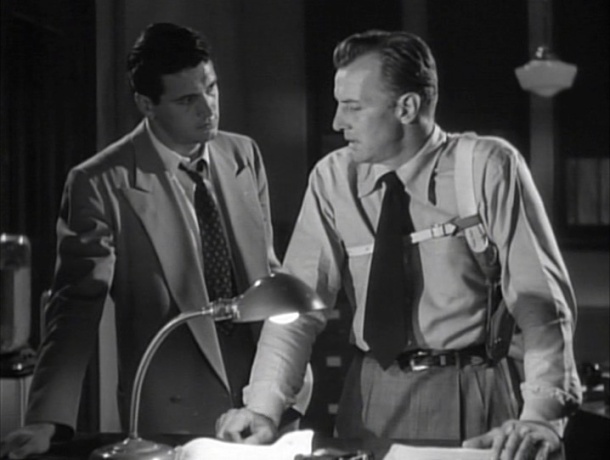
Undertow (1949)
Directed by William Castle
Universal International Pictures
This review originally appeared last year at Film Noir of the Week.
William Castle is best remembered as the P.T. Barnum of schlock cinema. Castle was a director, producer, and huckster who sold his flicks to the public with brilliant gimmicks. Anyone who bought a ticket to Macabre (1958) was insured by Lloyd’s of London against “death by fright” while watching the picture. People who went to see The Tingler (1959) took a chance that they might be joy-buzzed if they were lucky enough to sit in one of the right seats. And people who bought a ticket to see the Psycho-inspired film Homicidal (1961) were promised their money back if they walked out during the one-minute “Fright Break” before the climax of the film. Provided, that is, they were willing to stand on display in the “Coward’s Corner” in the lobby until after the film ended.
What people tend to forget, however, is that before he made Macabre, Castle was a hard-working, dependable director of low-budget studio pictures. He was under contract at Columbia Pictures from 1944 to 1947, where he made several films in the Whistler series and the Crime Doctor series, as well as B noirs like When Strangers Marry (1944), which starred Robert Mitchum and Kim Hunter.
While under contract with Universal in 1949, Castle directed two B noirs, Johnny Stool Pigeon, which starred Howard Duff and Shelley Winters, and Undertow, which starred Lawrence Tierney’s little brother, Scott Brady.
Just like his big brother’s loony film noir classic Born to Kill (1947), Undertow starts out in “The Biggest Little City in the World” — Reno.
Brady plays a good-natured, average guy named Tony Reagan who’s just gotten out of the Army after a seven-year stint (he stayed in for another hitch after the war). All Tony wants to do is help his dead war buddy’s dad run the Mile High Lodge, 40 miles north of Reno, and spend the rest of his days hunting and fishing. The only thing he has to do first is fly to Chicago to see his best girl, Sally Lee (Dorothy Hart), and convince her uncle — gambler “Big” Jim Lee — that he’s good enough to marry her.
While in Reno, however, Tony runs into his old friend Danny Morgan (John Russell). Danny tries to convince Tony he’d be better off helping him run his casino. His sales pitch to Tony is: “Lots of sunshine, steady supply of suckers. And loads of lovely, lonely, loaded ladies.”
As I said, Tony is a good-natured, average guy, and even though he knows his way around a craps table, he’d rather put that part of his life behind him.
If you’re a fan of film noirs, however, you know that good-natured average guys who’ve just rotated out of the service are statistically the most likely people to have a murder rap pinned on them and be forced to flee from both the cops and the bad guys.
Arthur T. Horman and Lee Loeb’s screenplay for Undertow is standard stuff. It’s fine for what it is, but it’s not that different from any number of other B noirs about an innocent man on the run. However, Undertow is worth seeking out for several reasons.
First off, the direction is great. Castle knew how to make an entertaining, fast-moving film, and Undertow is one of his better pictures from the 1940s. Another reason to see Undertow is all of the location shooting in Reno and Chicago, which is rare for a 70-minute programmer.
Castle does more than just throw in a few establishing shots. When Tony Reagan first arrives in Chicago, he heads for the Palmer House hotel, then attempts to lose a police tail while walking down South Wabash Avenue and running up into the elevated train station on the corner. Two scenes in Undertow take place at Buckingham Fountain, and at one point Tony meets his friend Ann McKnight (Peggy Dow) and his girlfriend Sally at the John G. Shedd Aquarium. The people in the background in the street scenes don’t look like Hollywood extras, either.
Another reason to see Undertow is to catch Rock Hudson in a very small role. This was the first credit Hudson received for a motion picture. He previously appeared in one other film, Fighter Squadron (1948), but his name didn’t appear in the credits. In Undertow he’s credited as “Roc” Hudson. He appears as a Chicago police detective for about one minute toward the end of the film in a scene in which he discusses a case with Det. Chuck Reckling, played by Bruce Bennett.
I’ve seen a lot of Lawrence Tierney’s films, but I’ve only recently seen films starring his younger brother, Scott Brady (whose real name was Gerard Kenneth Tierney). Brady very closely resembles his older brother. It would probably be difficult for most people who’d never seen either of them before to tell them apart.
But while Lawrence Tierney played nasty, sociopathic characters the way other actors pick up the phone and say, “Hello?,” Scott Brady projected a general air of decency. From what I’ve seen of him so far, his performances aren’t as memorable as Tierney’s, but he’s perfect for this kind of role.
Finally, one last reason to see Undertow is for some truly outstanding bits of noir photography by Castle and his cinematographers, Irving Glassberg and Clifford Stine. The location shooting establishes the world of the film nicely, and is fascinating from a historical perspective, but it’s scenes like the climactic chase down a dark hallway that really tie the film together.



